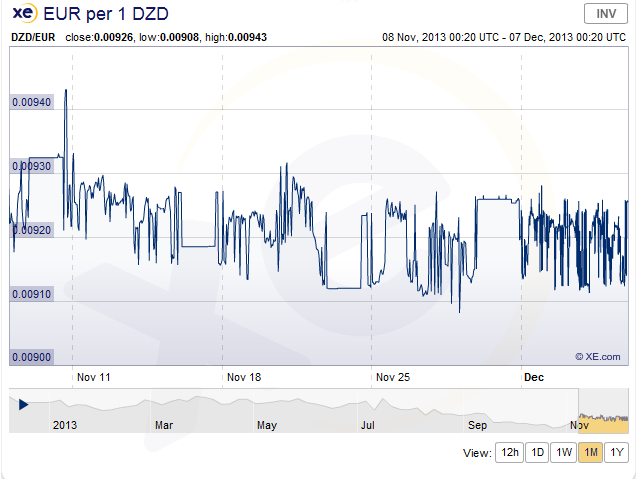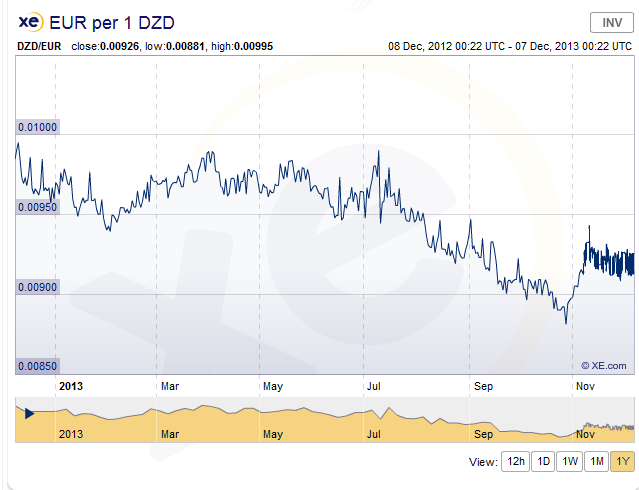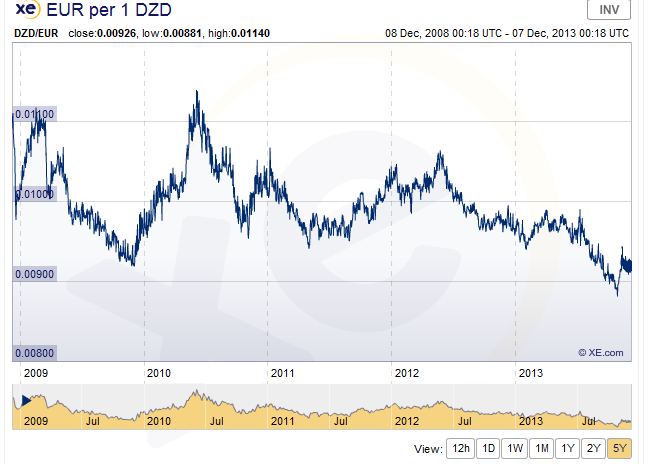Comparative advantage
Algeria has a gross domestic product of about $205.5 billion according to the statistics of the year 2012. The country’s gross domestic product growth rate is about 2.7%. Its GDP per capita stands at about $7,601 PPP. Before independence, the French developed a close relationship with the country’s economic growth, social development and political progress.
After independence, the Algerian government transformed its economy through various programs that it developed in the central structure. The country also made efforts to privatise the country’s economy as one of the strategies of attracting foreign investment. However, the country encountered economic debts with foreign liabilities rising to about US $32 in 1999.
After these difficult financial problems, the government of Algeria introduced a series of economic restructuring measures to promote and sustain the country’s economic development. These reforms were crucial in accelerating economic growth and transformation. The hydrocarbons sector forms the pillar of the Algerian economy.
About 94% of the country’s economy relies on hydrocarbons. The sector is essential for the realisation of the country’s foreign exchange and economic growth. However, the country also has other critical sectors like the political domain, social factors, the legal framework and the environment.
The disadvantages of dependence on the hydrocarbons sector for Algeria include vulnerability to economic uncertainties. The country also operates in a poor commercial setting. This aspect poses a huge problem for foreign corporations operating in the country.
This paper examines several comparative advantages of the Algerian economy. This fact underscores the need to invest in the country through the Algerian Wool Company. For instance, the country’s economy recorded growth of about 2.6% in the year 2012 (Lapadre & Proietti, 2009).
This fact was an increase from the 2.5% growth of the country’s economy recorded in the year 2011. The country also continues to undergo restructuring that intends to modify its economy.
However, certain disadvantages also continue to derail the development of the economy like a continued rise in the country’s inflation. Experts estimated that Algeria’s inflation increased to 8.8% in 2012 from about 4.7% in 2011. The other disadvantage is the continued widening of the country’s budget deficit.
For example, the deficiency broadened to about 3.4% of the country’s gross domestic product in the year 2012. This aspect was in contrast to the budget deficit of 1.4 % in the year 2011 (Freund & Ornelas, 2010). The good performance of the financial authorities led to an increase in budget reforms. This paper observes a significant improvement in the economic performance of the modernisation deficit.
However, this aspect not only led to an increase in budget deficits of about 3.5 % of the gross domestic product but also an improvement in the country‘s 2012 economic modernisation processes. This point was an effort by the Algerian government to align itself with the expansion and social demands of the community. Statistics indicate that Algeria’s external position was stable in the year 2012.
This fact was evident as shown by the trade benefits amounting to a surplus of about USD 27.19 billion. In addition, trade experts estimate the present-account surplus to be at 8.4% of GDP. The professionals approximated the official foreign-exchange reserves to be USD 190.9 billion at the end of December 2012, or the equivalent of more than three years of imports of non-factor goods and services.
Oil and gas export earnings contributed up to 98% of Algeria’s total exports in 2013 (Sapir, 2011). The country has several opportunities to improve its prospects of economic growth. The instances include the development of the oil and gas industries. These sectors have the potential of developing into a massive unit of foreign exchange reserves.
Trade relations
The Algerian government is a candidate member of the Great Arab Free Trade Area (GAFTA). The government also maintains a keen interest in securing free trade areas with the West African Monetary Union and Iran. The government reached a decision to join GAFTA on the 3rd of January, 2009. The advantage of this membership is the improvement of Algeria’s capacity to raise the entire business sector.
However, the country faces diverse challenges due to its membership to the GAFTA. For example, the corporate sector may lose its profits as a result of the massive influx of commodities from other member countries. A number of corporate businesses may incur losses due to cheap imports from other Arab states.
This report affirms readjustments by certain firms that wish to reduce their cost of production through processing outside Algeria. A number of characteristics of the Great Arab Free Trade Area include membership of the Arab region.
The region comprises of different agreements that include the Euro-Mediterranean Partnership, the Egyptian Association Agreement with the EU, the Algerian Association Agreement with the EU, the Greater Arab Free Trade Area (GAFTA), the Bilateral FTAs of Arab countries with the US and the Jordanian Free Trade Agreement with the US (Lloyd & Maclaren, 2009).
The GAFTA seeks to provide unique services to clients through effective access to economic markets. The regional blocs also endeavour to promote industrial market access, agriculture, Singapore issues, boost intellectual property rights, and achieve the implementation of the free trade area issues and to share national processes and experiences. The country is also a member of the World Trade Organization.
The Algerian government is part of a trade agreement with the European Union. The country signed a trade accord with the European Union in 2002, in Spain. The consensus took effect in October 2005. The trade accord was part of the European Union’s agenda and the continuation of the “Barcelona process”.
The objectives of the process are to transform the Mediterranean region into a massive free trade zone. The zone may be under the dominance of the European Union.
This trade agreement engaged Algeria as part of the “Barcelona process” that marked territories for the free trade operations of the European Union until the year 2017. In addition, the European Free Trade Association that includes countries like Norway, Iceland, Switzerland and Lichtenstein expressed a keen interest in forming a similar partnership with Algeria.
Algeria is in discussion with the United States of America. It intends to have an agreement with the US as part of America’s strategy to develop an American Middle East free trade zone. The area may extend into the Maghreb by the year 2013.
The country has a trade and investment framework agreement with the United States. This initial agreement provides a basis for the establishment of the United States Free Trade Association. Algeria also has a free trade agreement with the government of Tunisia.
Algeria records an impressive score of 49.7 as its economic freedom rating. This aspect ranks the economy at position 144th across the world as one of the “freest” economies in the 2013 market index. However, the overall score is about 1.5 points lower than the year 2011 (Magee, 2008).
This point shows that there has been a decline of trade freedom in the country. Experts rank the country in position 14 among the 15 states in the North Africa and Middle East zone. In addition, the country’s score remains lower than the regional and world standard scores.
The economic performance of Algeria has been inconsistent over the last few years. The government of Algeria has made several efforts to boost the growth of the economy through trade agreement and membership to regional associations. Most of these trade accords and association to regional blocs should improve the performance of the economy and create trade.
A number of the accords in Algeria like the Algeria-EU Association have had a tremendous impact on the Algerian trade. The treaties have led to trade creation in most sectors of the economy like in the hydrocarbons and non-hydrocarbon sectors.
In addition, the Algerian economy realised great economic improvements as a result of the entry into the economic treaties. Regional membership may create trade for member countries (Panagariya, 2009). The associations may not be adequate in overcoming the pressure of exports and regulation of trade.
However, trade relations and institutional linkages continue to have a significant influence on the long term economic development of the country. For instance, weak institutional capacity undermines the opportunity of the fast rate of expansion of the Algerian economy. The structures that create economic freedom and efficient trade relations are crucial parts of success in commercial enterprises.
This factor remains fragile when it comes to Algeria because of social vices like corruption, inefficiency and impunity within the systems of justice administration (Peridy, 2007). The country is also vulnerable to interference from external political forces and deals.
In addition, the prospects of political uncertainty in the country and the existence of a remorseful attitude towards foreign investment are also a disadvantage that may affect the success of the Algerian Wool Company. Algeria has the potential of gaining a comprehensive integration with the rest of the world through competitive trade agreements and investment initiatives.
However, there have been little efforts from the Algerian government to improve the status of the country’s fiscal governance. For example, the social unrest of 2011 reveals the unpreparedness of the government to manage several political instabilities in the financial market.
Predicting future exchange rates
Fundamental analysis
Demand and supply factors are crucial in the determination of the country’s exchange rate. The elements of the equilibrium of payments reveal the sources of demand and supply. The different components of the balance of payments include the current, capital, and official reserve accounts and the statistical discrepancy.
The concept of balance of payments may refer to the statistical record of a country’s international business transactions over a set time in the form of double entry accounting. The notion may relate to the transactions of a country’s citizens and government. The idea may involve the techniques that countries use to monitor and evaluate international monetary transactions over a given period.
Accountants normally calculate the balance of payments on quarterly and annual terms. The balance of payments accounts for all trade transactions made by public and private sectors. These transactions help in the determination of the revenue from exports and expenditure on imports.
The difference between the expenditure and the earnings provide the balance of payments. A balanced payment is usually at a zero point. This fact implies that the cost of imports becomes equivalent to the revenue on exports.
Essential factors that may affect the value of a foreign currency include market demand, supply and sentiment, economic and political factors, inflation, balance of payments historical patterns and the dollar index.
Inflation varies according to different countries. Economies with a low level of inflation may have competitive exports. This aspect may increase the demand for their currency and goods. It may also reduce imports from countries with high inflation. Countries with low inflation levels have a high appreciation of the value of their currency.
International trade between states dictates the supply and demand of commodities in world markets. This aspect may cause demand for certain currencies and improve the rating of the value of the currency (Philip & Marshall, 2010).
Market sentiment denotes the factors that determine the market and may affect the stock index. These elements may include consumption, employment and market of stocks and bonds (Romalis, 2008). These components may affect the value of a currency especially when commodities enter and leave the market. Economic and political factors are also significant in the determination of the value of a currency.
Political instability may lead to a decline in the country’s currency value. Historical patterns are crucial indicators of the probable performances of currencies. Experts deliberate these aspects on account of the technical evaluation of the money market. Currency patterns tend to be repetitive ((Freund & Ornelas, 2010).
This aspect enables businesspeople to make assumptions on future trades and their potential paths. The dollar index is a graph that tracks the performance of the dollar against other main currencies. It helps to develop a preliminary presumption of the strength or weakness of the dollar (Sapir, 2011).
The indications of the chart may affect the value of the dollar through manipulation of market decisions. A country that struggles to balance or has more imports than exports may have a low currency value.
Technical analysis
The currency that is applicable in Algeria is the Algerian Dinar. The currency’s rankings show that the DZD to EUR rate is the most common exchange rate in Algeria. DZD is the currency code of the Algerian Dinar. In contrast, France uses the Euro currency. In the year 2002, the French government adopted this currency to replace the French Franc as the official currency of the country.



Hedging strategy
A number of the different currency flows that the Algeria Wool Company may include the initial investment in Algeria. This point may comprise of manufacturing of different products using the wool material like sweaters, jumpers and hoods. The emphasis on production may be made on the high grade sweaters that can be potentially sold to French upper and middle class populations.
Apart from their sale in France, the woolen products may also be sold in Algeria but for a lower price due to local production. A portion of accrued profits may be used for the expansion of the company in Algeria while others may be spent in France.
The hedging strategy denotes the methods and techniques that may be used to protect the Algerian Wool Company from collapsing. The approaches may protect the company from the risk of losing value in the Algerian market and thus help it to flourish. In addition, hedging may refer to insurance of the business that may reduce financial risk.
This paper outlines various hedging instruments available for application in the context of the Algerian Wool Company. The common tools include future and options, stock market investments, forward and interest swaps (World Bank, 2011). These tools may reduce risks and boost additional earnings for the company.
The instruments may allow the investor to put capital into two negatively associated products. They can reduce the impact of the threat. The approaches postulate that higher risks may bring about positive prospects to a business or chances of a loss.
Overall conclusion and composite draft
This paper explains the different components that may promote the success of an invented company. I chose Algeria and France because the two countries have a long term relationship that dates back to the colonial period. The paper explains the development of the idea of inventing a company called the Algerian Wool Company.
The business intends to manufacture different products using wool as the raw material. The paper provides a comprehensive review of the Algerian economy and how it relates with France. It builds an understanding of the two economies to present a rationale for the selection of the company and how it can succeed. The progression of the analysis helps the development and consolidation of the invented company.
References
Freund, C., & Ornelas, E.(2010). Regional Trade Agreements. Washington, D.C.: The World Bank.
Lapadre, L., & Proietti, A. (2009). Statistical analysis of international trade and production: towards a scoreboard of indicators. Connecticut, CT: Cengage Learning.
Lloyd, P. J. & Maclaren, D. (2009). Gains and Losses from Regional Trading Agreements: A Survey, Economic Record, 80 (2), 445-467.
Magee, C. (2008). New Concepts of trade development and diversion. Journal of International Economics, 75 (6), 340-362.
Panagariya, A. (2009). EU preferential trade arrangements and developing countries.The World Economy, 25 (10), 1415-1432.
Peridy, N. (2007). Trade Impacts of the Euro–Mediterranean Association: Lessons for ASEAN countries. Journal of Asian Economics, 16 (7), 125-139.
Philip, D., & Marshall, J. (2010). Pricing Long Bonds: Pitfalls and Opportunities. Journal of Financial Analysts. 1(1), 32-39.
Romalis, J. (2008). NAFTA’s and CUSFTA’s Effect on International trade. Review of Economics and Statistics, 89 (12), 416-435.
Sapir, A. (2011). Domino effects in Western European regional trade, 1960–1992. European. Journal of Political Economy,17(2), 377-388.
World Bank.(2011). Doing Business in Algeria. Web.